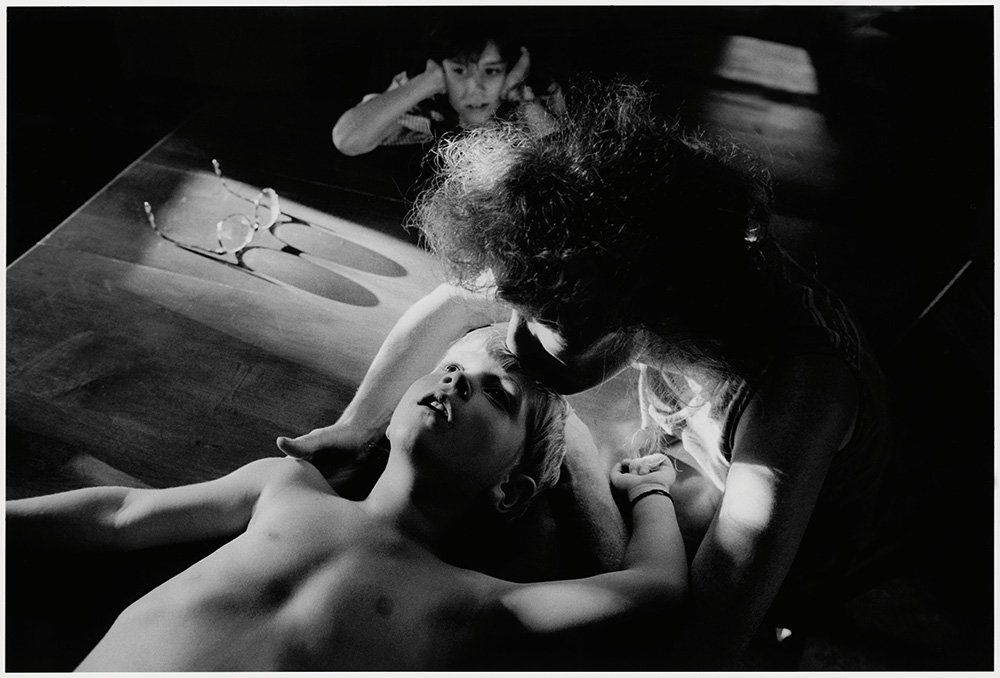Long before “multimedia” entered the vocabulary, there was Larry Towell–bearing witness and giving voice to the victims of war, natural disaster and AIDs. In field recordings, film, and video. In protest songs in the tradition of Woody Guthrie. And in poetry and prose, he remains a passionate advocate for the dead, the disappeared, and the dispossessed around the world. Least we forget our own good fortune, the 75-acre farm where he and his wife raised four children, is Towell’s other subject. The Leica rangefinder—and 35mm film—which Towell still uses, were almost an afterthought, much like his application to join Magnum Photos in 1988. In an excerpt from the commentary to his book The Mennonites—the result of ten years spent among their communities in Canada and Mexico—Towell writes about his upbringing, family, and discovery of photography.
—Guy Lesser


It all started for me as a boy along the goldenrod paths and cow pastures that led me to the river and into the hardwood forests where I began to listen to nature and collect insects, flowers and animal bones. That brought me to the abandoned farmhouses and barns of southwestern Ontario, where I discovered the unofficial museum and the meaning of personal photography, and from there, to the war-ravaged countrysides of Central America and the burned-out villages of landless farmers, then to the refugee camps of Palestine. It made me look at my own land differently.
My mother stared into a ploughed field at the space where her childhood home once stood. The barn had been flattened by a tornado in the mid 1940s. She never saw the house, years later, collapse with age. Below the soil, the footings of buildings are buried and the refuse has been tilled under. She took a picture of the empty field. Pictures anchor us. In the Winter of 2007, I attended my aunt’s funeral in the village of Merlin, and from there, navigated several country roads to where, forty-five years ago, I’d watched my teenage uncle throw a dagger into a willow tree, its crotch the bull’s-eye. My grandfather smoked in a chair. He rose and stood with his back toward me to change the bandage on a hand that had been mangled in a corn picker and would eventually fuse into a stump. He didn’t want me to see it. Chickens scattered. My grandmother did not approve of the knife. She said it was killing the tree. Many of the pictures I have from her side of the family were taken between the tree and the new drive shed. My mother’s parents took very few photographs, so from six months’ allowance for doing chores, she bought a Brownie box camera for six dollars. At age thirteen, she became the family photographer, taking pictures of much of what exists on or near that spot. When I was thirteen, she gave that camera to me. I made my first picture at Niagara Falls where The Maid of the Mist floats in a blur of vapour. I know my father’s parents only by their pictures. Grandpa Towell, who played fiddle, bones and fife, would disappear into the lumber camps each fall and return home in spring when frost had heaved a new crop of rocks, like pre- historic eggs, onto his pastures. Trees were in his veins, but stones were his most abundant crop. We are what we photograph. He brought a camera into the lumber camps, although he shot sparingly. The first photographer in my family was Samson West, who processed his own film, made his own prints, and shot with flash powder. He was the real thing. My great-uncle Charlie, Samson’s son-in-law, was the next man in the family to take pictures. As a guide in the northern wilderness, he carried a camera in his rucksack to document the deer and moose his clients shot, the fish they caught, and the waterfalls and trappers’ cabins they encountered. At farm auctions, where the personal artifacts of rural life were spread onto hay wagons to be picked through and bid upon, I have purchased shoeboxes of disregarded love– three men lean against the Hood of a pick-up, a pregnant woman smiles under a thin man’s arm, a child holds her grandpa’s hand in a barnyard, and a baby in a washtub is being bathed among a shower of black and White zinnias. Who took these pictures of yellowing impressionist flowers? Both the photographer and the subject are null but for the spirit that lies tenderly asleep. In the 1960s, the rural Ontario landscape was depopulating, leaving abandoned farmhouses to decay like mushrooms in the paddock. As a boy, I’d wandered through pioneer kitchens where I held in my small hands the ghosts of hopeless speculation.

Land ownership was centralizing at the expense of the family farm. A plague of locusts originating from bankers’ desks was vanquishing the rural community. Land had become a commodity rather than a resource. The first generation of farm children were moving to the cities, and with rural depopulation went many of its schools, churches, community centers and other organizations, a trend that would become endemic, as well as global, by the twenty-first century. Today, one human being in six lives in a “squatter city”, as a farmers throughout Asia, Africa and Latin America migrate from the plots of land they farmed for generations and on which they can no longer subsist, to live in urban slums. Thirty-five million persons also live in exile, cut off from their rural origins, often as a result of confliction over land. Although I travel extensively now, it is with a sense of exile. From Hanoi to Managua, from San Salvador to the Israeli-Occupied Territories, the longing for home persists. Although a journalist must work in the arena of international events, when I am not traveling, I turn the camera inward.

Larry Towell | The Mennonites
Photography: Larry Towell @ Magnum Photos